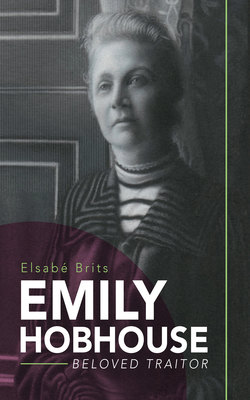Читать книгу Emily Hobhouse: Beloved Traitor - Elsabé Brits - Страница 5
На сайте Литреса книга снята с продажи.
Introduction
ОглавлениеIn the winter of 2013 I came across Rykie van Reenen’s book on Emily Hobhouse, Heldin uit die vreemde, in a bric-a-brac shop in Prince Albert in the Karoo. Like many other people I had been familiar with Emily’s story in broad terms, but there were things in this book that stuck in my mind. What left a strong impression was that Emily had been much more than the upper-class British woman who took the plight of the women and children in concentration camps in far-off South Africa to heart during the Anglo-Boer War.
I started reading more about her, including books that my wife, Carol, had ordered for me from overseas. The “last straw” was when I read about the ingenious ploughing plan Emily devised to get the defeated burghers of the Transvaal and the Free State back on their feet after the Anglo-Boer War. Besides, it fascinated me that so little was known in South Africa about Emily the liberal socialist, the pacifist and the feminist.
This was how it came about that, 14 months later, I found myself in a car with Will, a Canadian motel owner, on a dirt track on Vancouver Island. The track wound through an avenue of trees past an asparagus farm and a school, ending at a wooden house. In the doorway stood a small, slightly stooped woman with wispy snow-white hair.
Jennifer Hobhouse Balme. “Ah! You’re here,” she said. “Welcome!” As we greeted each other, I clasped both my hands around hers.
Finally, after an almost year-long e-mail correspondence, some slight subterfuge to gain access to the British Library in London, a near-indecent search at Vancouver International Airport and a journey of a few thousand kilometres from South Africa, I had arrived in a small fishing village on Cowichan Bay on the Pacific Ocean.
Jennifer’s grandfather, Professor Leonard Trelawny (LT) Hobhouse, was Emily’s younger brother. Jennifer (born in 1929) is probably the last surviving person who can relate anecdotes about Emily that she heard first hand from relatives of her great-aunt. A year earlier, in September 2013, I had tracked Jennifer down and we started corresponding. She had mentioned that her father, Oliver, had bequeathed her a trunk and a few boxes containing some of Emily’s effects, but without providing much detail.
After inviting me inside, she started explaining her family tree in her study on the top floor. Her grandfather, LT Hobhouse, an eminent professor of sociology, was not only Emily’s younger brother but also the sibling who had been closest to her. His son, Oliver Hobhouse, had been the apple of Emily’s eye, and finally also her heir. And Oliver was Jennifer’s father.
As Oliver’s only surviving child, Jennifer inherited everything Emily had bequeathed to him. And after Jennifer married a Canadian in 1966, Emily’s effects had accompanied her to Canada.
A small sewing table that had belonged to Emily stood in a corner of the study. Two of her books – The Brunt of the War and Where it Fell and War Without Glamour – were on the shelf.
On the coffee table lay a pile of handwritten pages, wrapped in now old and worn-out brown paper. “This is her draft autobiography, just as she left it,” said Jennifer, who herself had written two books on Emily – To Love One’s Enemies and Agent of Peace. Dressmaker’s pins that were nearly a century old still kept the pages together. It was one of only two copies Emily had written by hand. She had typed parts of it, sometimes with the typewriter on her lap as she lay in bed in her last years.
She had started working on it in 1922 but was unable to complete it before her death. Sections had been typed by other people.* The manuscript is in the form of a long letter to the woman who was probably her best friend, Rachel Isabella (Tibbie) Steyn, wife of the Free State president Marthinus Steyn.
“That box contains her material on the Anglo-Boer War,” Jennifer said, pointing to boxes on the floor, “and in that one is everything on Germany and the First World War … You know about the children in Leipzig, don’t you? And the Russian babies?” There was a trunk, too.
Inside the trunk was a box. As I lifted it up, there they lay: three scrapbooks Emily had made; two about her experiences in South Africa, and one about her work in Germany after World War One. Furthermore, an older scrapbook with sketches made by Emily’s mother, and some photos!
And, to crown it all, the trunk also contained four A5 hardcover notebooks, all neatly marked. Diaries. Nowhere had I read or heard of the existence of these notebooks.
These records had survived the Second World War in Oliver’s barrister’s office in London amid hundreds of buildings that had been demolished during the air raids. The trunk also contained hundreds of letters, documents, photos and a copy of Emily’s draft autobiography.
All of these treasures were here, on an island in Canada. What a wondrous find!
I was literally trembling with excitement. Here I hoped to find answers to many of my questions about the enigmatic and indomitable Emily: Who was she really, and what had led to her being spurned by her country, many of her friends and even some of her relatives? Would it have been different if she had been a man?
How did she manage to break through the stifling confines of the Victorian era in which she had been born and become a citizen of the world? What had possessed her to travel to a remote dark continent and identify with the plight of people to whom she had no ties?
Was she a hero or a villain? Or perhaps even a traitor?
